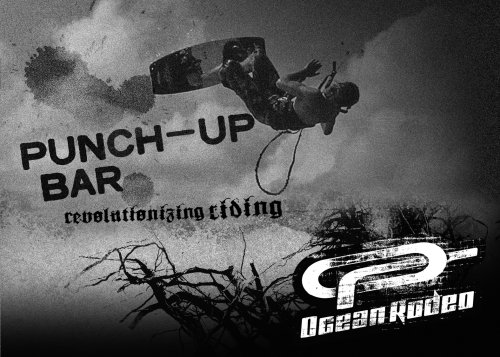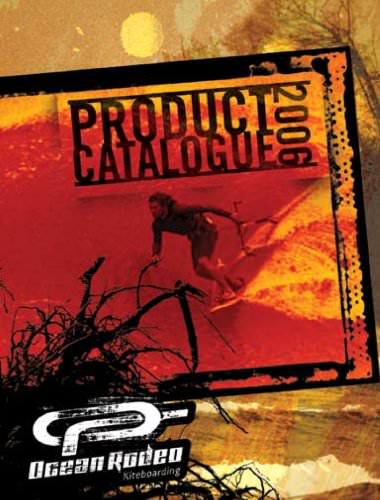
Catalog excerpts

Notes _ _______________________________________________ _ _ _______________________________________________ _ _ _______________________________________________ _ _ _______________________________________________ _ _ _______________________________________________ _ _ _______________________________________________ _ _ _______________________________________________ _ _ _______________________________________________ _ _ _______________________________________________ _ _ _______________________________________________ _ _ _______________________________________________ _ Take a lesson!...
Open the catalog to page 2
Table of contents Important Notice________________________________4 Kite care and maintenance______________________20 Introduction_ ___________________________________4 Strut bladder removal___________________________20 Caution_________________________________________5 Repairing the bladder___________________________22 Selecting Kite size_______________________________6 Strut bladder replacement______________________22 Location________________________________________6 Leading edge bladder removal___________________24 Assembly of kite_________________________________7 Leading edge bladder...
Open the catalog to page 3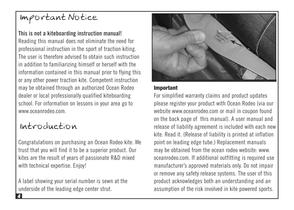
This is not a kiteboarding instruction manual! Reading this manual does not eliminate the need for professional instruction in the sport of traction kiting. The user is therefore advised to obtain such instruction in addition to familiarizing himself or herself with the information contained in this manual prior to flying this or any other power traction kite. Competent instruction may be obtained through an authorized Ocean Rodeo dealer or local professionally qualified kiteboarding school. For information on lessons in your area go to Congratulations on purchasing an Ocean Rodeo kite. We...
Open the catalog to page 4
Co.W¿iOIA vSo.J'e.'ètj WO-VIAÍIAQ Kite powered sports can be very dangerous and physically demanding. The user of this predict should understand that participating in kite powered sports may involve serious injury or death and agrees to observe the following safety precautions: • Get instruction specific to the type of kite power craft. • Obtain first aid training and carryfirst aid and safety/rescue devices. • Consult your physician prior to beginning kite powered sports training. • Always wear a nationally approved personal floatation device when using a kite on water. • Always wear a...
Open the catalog to page 5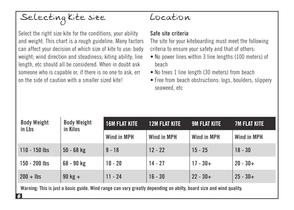
Select the right size kite for the conditions, your ability and weight. This chart is a rough guideline. Many factors can affect your decision of which size of kite to use: body weight; wind direction and steadiness; kiting ability; line length, etc should all be considered. When in doubt ask someone who Is capable or, If there is no one to ask, err on the side of caution with a smaller sized kite Safe site criteria The site for your kiteboardlng must meet the following criteria to ensure your safety and that of others: • No power lines within 3 line lengths (100 meters) of • No trees 1...
Open the catalog to page 6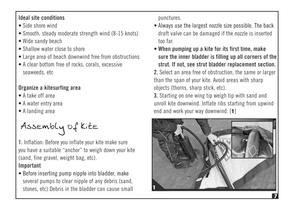
Ideal site conditions • Side shore wind • Smooth, steady moderate strength wind (8-15 knots) • Wide sandy beach • Shallow water close to shore • Large area of beach downwind free from obstructions • A clear bottom free of rocks, corals, excessive seaweeds, etc Organize a kitesurfing area • A take off area • A water entry area • A landing area punctures. • Always use the largest nozzle size possible. The back draft valve can be damaged if the nozzle is inserted too far. • When pumping up a kite for its first time, make sure the inner bladder is filling up all corners of the strut. If not,...
Open the catalog to page 7
Inflate the ribs until they assume their shape and are firm. Note • The valves have a back draft flap, it is not required to pinch the valves to retain air pressure. • Make sure plug is secure in valve and held snug with Velcro closure. 2] [ 3a 3b 4. While holding the leading edge remove weight from wingtip. Work your way to the center of the leading edge tube. Clip pump onto pump leash3a] [3b] [ Note • Ocean Rodeo kites come with a dual valve system: one to inflate and one to deflate. 4] [ 2 • Under inflation of your struts and leading edge tube will adversely effect the performance of...
Open the catalog to page 8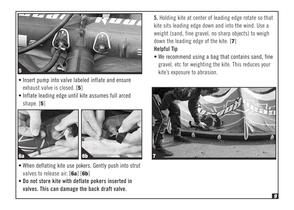
5. Holding kite at center of leading edge rotate so that kite sits leading edge down and into the wind. Use a weight (sand, fine gravel, no sharp objects) to weigh down the leading edge of the kite. 7] [ Helpful Tip • We recommend using a bag that contains sand, fine gravel, etc for weighting the kite. This reduces your kite’s exposure to abrasion. 5 • Insert pump into valve labeled inflate and ensure exhaust valve is closed. [5] • Inflate leading edge until kite assumes full arced shape. 5] [ 6a 6b 7 • When deflating kite use pokers. Gently push into strut valves to release air. [6a] [6b]...
Open the catalog to page 9
Ocean Rodeo "Flat" kites should be used with the Punch UP kite bar. We recommend you read and become familiar with the contents of the Punch UP bar manual in addition to this manual. The Increased de-power of the flat kite design can only be realized when used with a bar that offers excessive sheeting control as offered by the For up-to-date Information on this bar please visit: www.OceanRodeo.com/ Wingtips Parallel Line Lengths And Tuning All lines must be of equal length when measured from bar to end of lines with the center line un-cleated and fully extended. With all lines equal the...
Open the catalog to page 10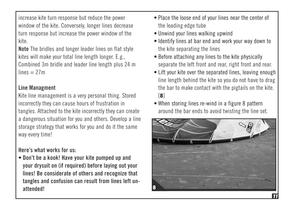
increase kite turn response but reduce the power window of the kite. Conversely, longer lines decrease turn response but increase the power window of the kite. Note The bridles and longer leader lines on flat style kites will make your total line length longer. E.g., Combined 3m bridle and leader line length plus 24 m lines = 27m Line Managment Kite line management is a very personal thing. Stored incorrectly they can cause hours of frustration in tangles. Attached to the kite incorrectly they can create a dangerous situation for you and others. Develop a line storage strategy that works...
Open the catalog to page 11Archived catalogs
-
Drysuit
10 Pages
-
SLE Bar
20 Pages
-
Product catalog 2006
15 Pages
-
Kite
15 Pages
-
Board
9 Pages



